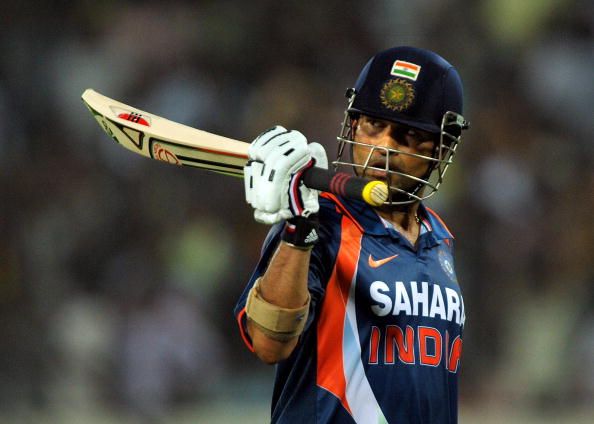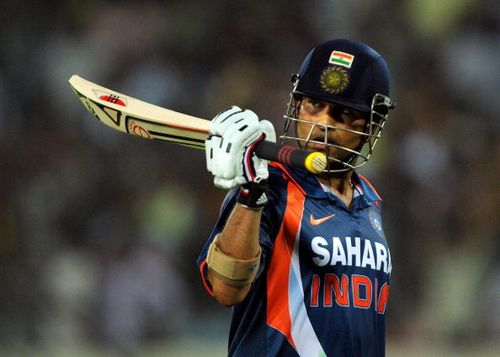
A Tendulkar Classic: India vs Australia, Hyderabad

Indian cricketer Sachin Tendulkar reacts after getting out, during the fifth One-Day International (ODI) between India and Australia at the Rajiv Gandhi International Cricket Stadium in Hyderabad on November 5, 2009
In the 90’s, the Indian team had 2 kinds of batsmen, Sachin Tendulkar and the others. Though Sachin had won some matches for India single-handedly, there were matches wherein Sachin played his part but India lost, thanks to the rest of the batsmen. With the emergence of the likes of Yuvraj Singh, Virender Sehwag etc. India no more relied on Sachin alone for victories. But in this epic match between India and Australia, with nearly 700 runs were scored, we got a glimpse of the old, fearless yet unlucky Sachin.
The Setting-
A 7-match ODI series between India and Australia in 2009. Australia took the first match, thanks to some tight bowling and some senseless batting from the Indian lower order. But the Indian team came back strongly, winning the next 2 matches thanks to some match-winning performances from Dhoni. India then lost the 4th match chasing a target of 250 odd runs due to lack of a major contribution from the batsmen. The 5th match was a day-night match played at the Rajiv Gandhi International Stadium, Hyderabad on the 5th of November.
Though the Australian team was weakened by the retirements of the greats, they were able to equally match the Indians. The Australian batsmen, led by an in-form Ricky Ponting, looked good; whereas new bowling talents like Ben Hilfenhaus impressed one and all.
The Indian batting looked quite good as usual, with captain MS Dhoni in prime form. Sachin and Sehwag looked good in patches, whereas Raina and Yuvraj stabilised the middle order. Ravindra Jadeja was included as an all-rounder for the team, thus bringing in depth to the batting and also some useful spin bowling.
Australian Batting
Australia won the toss and decided to bat first on a good batting pitch and could not have asked for a better start. The openers, Watson and Marsh, went after the bowlers, who looked helpless in that batting paradise. Harbhajan finally broke the partnership by taking the wicket of Watson. But the nightmare for the bowlers had not ended yet.
Shaun Marsh went on to continue his good form and scored a well-deserved century. Ricky Ponting, on the other hand, just maintained the run rate and rotated the strike with Marsh.
After the loss of Ricky Ponting to Praveen Kumar, Cameron White came to the crease and played a very useful cameo of 57 from just 33 balls. The bowlers looked more and more clueless in the final overs of the game. Even after the departure of Marsh, who eventually went on 112, Mike Hussey came to the crease and supported White. The Australian innings finally ended with a gigantic 350 for the loss of 4 wickets.
This target was indeed very tough to achieve considering the Indian batsmen’s tendency to crumble under pressure and most of the fans lost hope of an Indian victory.But the little master had other ideas.
Indian Batting
India needed a very good start if they had any chance of chasing the huge target imposed by the Aussies and the openers did not disappoint at all. In fact, on that day, it was Sachin who went after the bowlers. Considering that Virender Sehwag was at the other end, it was indeed surprising, yet nostalgic, to watch Sachin’s poetic straight drives, commanding cover drives and cheeky upper cuts. Yet again, like the days of the 90’s, Sachin fought the battle single-handedly without any support. With the exception of Sehwag, no other batsman even crossed the double digit score. India were reeling, with the scorecard reading 162 with the loss of 4 wickets. Then came in Raina.
Raina’s weakness against short pitched deliveries was common knowledge and the Aussie bowlers took no time to exploit his weakness. He huffed and puffed against the short bowling but stayed on at the crease. While Sachin went after the bowlers, Raina just played the supporting role, exactly what India needed at that time. He scored a valuable run-a-ball 59 and got out when the scorecard read 299.
Meanwhile Sachin achieved another milestone, scaling the 17,000 runs peak during the course of the match. Yet his concentration did not waver and he focused only on the target. When the scorecard read 332, with just 19 to get from 18 balls, Sachin played a shot against the impressive debutant Clint Mckay which he would later regret. He played a cheeky shot to clear the ball over fine leg, only to find the ball falling into the hands of Nathan Hauritz, the fielder stationed there. And thus, Sachin’s innings of 175 came to an abrupt end. The whole stadium, along with a billion fans around India, were in a state of shock. India did still have Ravindra Jadeja at the crease, the last recognised batsman. But even the Indian team did not recover from the shock of Sachin’s wicket. The tail and Ravindra Jadeja fumbled, thanks to the Aussie bowlers who held their nerve and India fell short of the target by just 3 runs.
This match proved to be decisive, as Australia won the series 4-2. Though India lost the match, most of the Indian fans will surely remember this match for a long time, a match where they saw a 36-year-old batsman batting like a 25-year-old boy, hammering the bowlers all over the park.